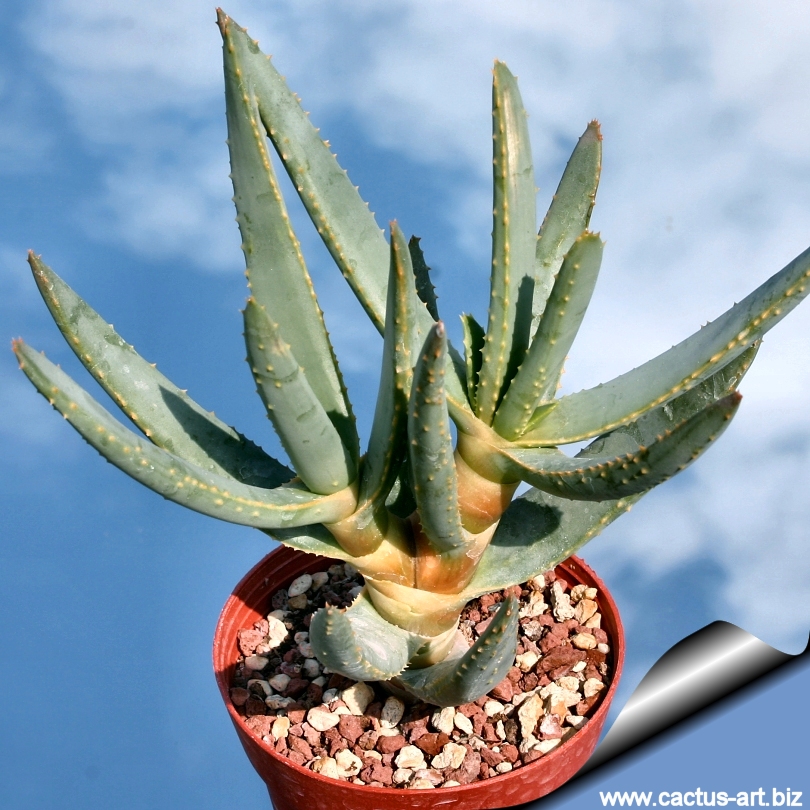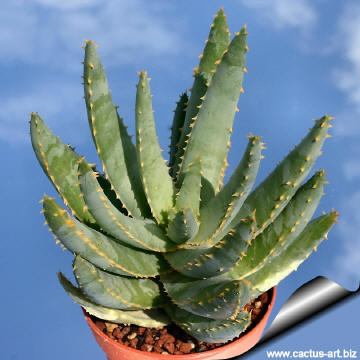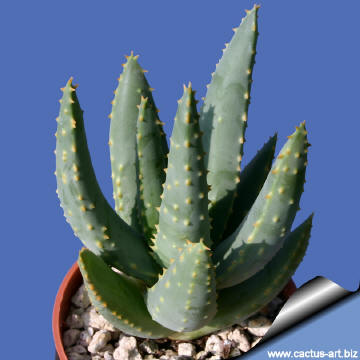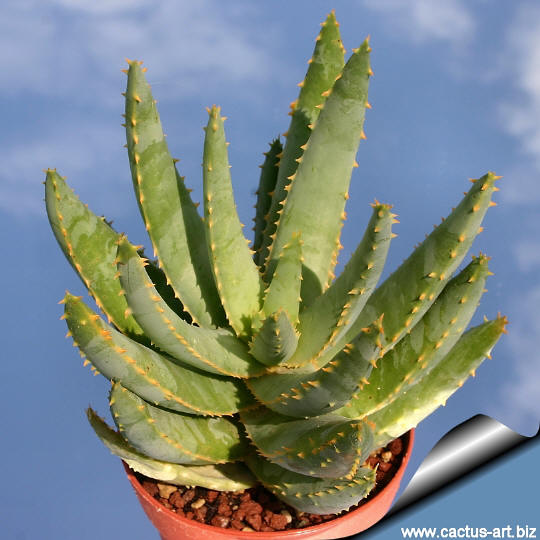|
|
|

Aloe ramosissima (A youn specimen)
A great collector’s Aloe that will grow slowly to 1,5 m tall. It
somewhat resembles
Aloe
dichotoma, but without a
stem and with more branches. Young trees looks like bonsai. Spectacular!
|
|
Description: It is a slow growing tree (shrub) type
aloe known for its many branches and smooth, white stems, and
without a doubt the most profusely branched of all aloes. It will form a
succulent bush up to 1.2(-1,8) m tall and wide. Other than this low
branching habit and usually smaller leaf size, it is virtually identical
to
Aloe
dichotoma, and some consider it a subspecies of A
dichotoma. Eventually forms large mounds.
Stems: As mentioned before, this aloe forms many branches from
the ground level. This is the only significant difference between
A. dichotoma and A. ramosissima. Branching
continues as the plant becomes older, resulting in a dense, almost
spherical shrub. The trunk is normally very short smooth and covered
with strips of satiny, waxy, powdery silver-pink-brown coloured bark,
which acts as a sunscreen in the harsh climate. The plants tends to be
longer-stemmed and less branched in more arid areas.
Leaves: The branches end in small rosettes of fleshy, oblong
leaves, each up to 200 mm long and 20 mm wide at the base. The leaf
colour is glaucous-green or yellowish green, often with a pinkish tinge.
The margins have narrow edges with small brownish teeth; base encircling
the stem.
Flowers: Bright yellow,
comparatively large, tubular; conspicuous, swollen, fleshy on a usually
3-branched short inflorescence, up to 200 mm long..
Blooming season (Europe):
Winter: Definitely slow to flower, like
Aloe
dichotoma, takes quite
awhile before it blooms, the first flower will be produced when
plants gets 1-1,5 m of height (about 10 to 15 old)
Fruits: Shiny and smooth dry capsule that split into three,
remaining fused at the base.
Seeds: Narrow, winged, up to about 30 x18 mm.
Taxonomists are now
starting to reclassify this plant as a form of Aloe dichotoma
Traditional uses:
Unlike A. dichotoma, there are no
cultural or medicinal uses associated with the maiden's quiver tree.
However, it is known that the very young flower buds can be eaten and
taste a little like asparagus.
The branches of this plant were used to make small quivers by young men
who then gave these quivers to young ladies as a sign of their
affection.
|
 |
 |
|


Advertising
|
|
|
|
|
|
|
Family: Aloaceae (Asphodelaceae)
Scientific name:
Aloe ramosissima Pillans
Common English Names include:
Maiden's Quiver Tree
Origin: Southern Africa (Richtersveld),
southern Namibia.
Conservation status: Listed in
CITES appendix 2.
Habitat: The plants is from
the winter rainfall of Southern Africa's Namib Desert and occur in very
arid, rocky places on hills and mountains. They rely on winter rains
that average around 110 mm or less per annum. It is not at all uncommon
in this area for summer temperatures to rise to 46º C and years may pass
before any rain falls.
Ecology:
The bright yellow flowers produce
nectar which is harvested by sugarbirds and ants. Generally, flowers are
pollinated by bees and ants. When capsules dry out, the winged seeds are
carried by the wind, often landing in bushes where they germinate,
making full use of the shelter and shade. Plants eventually outgrow the
nurse plant, killing it in the process. The fleshy leaves and stems
act as water reservoirs in times of drought and the grey powder on the
stems reflect intense heat away from the plant.
Etymology: According to one
theory, the genus name Aloe is derived from the Arabic word
"alloch" or
from the Greek and Hebrew name "allal", meaning bitter. The latter is more
acceptable as aloes produce a very bitter sap. The species name
dichotoma (dichotomous) means forked and the variety name
ramosissima
means very much branched, referring to the distinctive growth form.
Synonyms:
- Aloe dichotoma var. ramosissima
|
|
|
|

The slow growth rate and relative
rarity of the plant make it a particularly sought after and expensive specimen.
Cultivation:
Winter grower, it is sometimes a
tricky grower and prone to rot. Like its closest relative, Aloe dichotoma, it has a very old and almost stressed appearance making this
an excellent and sought-after container plant or wonderful landscape
specimens in the garden, although it doesn't make a trunk. When growing
this Aloe, one must be careful not to overwater. It is best
suited to being grown in a pot around here so that it has excellent
drainage. If kept dry it is frost resistant and without
trouble.. Propagation: Plants grow easily
from seeds and once germinated develop rapidly. It is possible to grow
plants from cuttings but attempts are very seldom successful and
therefore not advisable..The problem is they don't start to form roots
until the start of the active growth season, which in begins in
September. Seeds are able to survive for many months, but it is better
to sow fresh seeds. Use coarse river sand mixed with fine compost, one
part compost and two parts sand. Cover seed lightly and keep moist. One
must be careful not to over-water and seedlings should be treated with a
fungicide to avoid damping off. Seeds of Aloe ramosissima are best sown
in autumn.
USE: The young flower buds
can be eaten and have a similar appearance and taste to asparagus.
Photo of conspecific taxa, varieties, forms and
cultivars of Aloe dichotoma.
|
|